Here's the "Artist's Statement" from my current exhibition "Fire and Ice: Marine Corps Combat Art from Afghanistan and Iraq"
When I tell someone I'm a combat artist for the United States Marine Corps three questions are invariably put to me. First, what is a combat artist? Second, what does combat have to do with art? And finally, why would the Marines Corps, of all organizations, have artists? The first question is usually asked with great curiosity, while the final question is often posed with a tone of incredulity. The answer to the first question is simple. A combat artist is an artist who goes to combat. This is no more and no less than a landscape artist going outdoors to find the visual and experiential content for their work.
The response to the second query involves a short art history lesson. Art and combat have been wedded since time immemorial. Whether it's a 5,000 year old pictograph painted onto a cave wall in Montana depicting a primitive spear brandishing warrior, the evocative 3rd century B.C. Greek statue entitled "The Dying Gaul", or Dutch master Rembrandt's painting "Nightwatch", we are talking about combat art. There is a reality and immediacy in each of these pieces that speaks of the individual artist's direct experience of war and warriors.
Many other well-known figures in art history have chosen to render images of war drawn from their personal experiences. Goya produced a dramatic set of etchings based on the horrors inflicted during Napoleon's occupation of Spain. Winslow Homer followed a Union sniper out into the field and his resulting image, "The Sharpshooter", is one of the most indelible images of the American Civil War. Egon Schiele sketched sickly Russian POWs with great compassion while serving in the Austrian Army during World War I. During that same war, John Singer Sargent painted the seemingly endless lines of gassed British soldiers. All of these body of works qualify as combat art, and at the same time they are each universally recognized as essential elements in the critical understanding of Western Art as a whole.
The third question, the one often posed with a raised eyebrow, is the most challenging to answer. The martial reputation and public perception of the Marine Corps is a powerful one, and in most of our minds heavily weighted in a direction away from anything remotely associated with art and culture. I recognize this stereotype is difficult to surmount. Admittedly, we Marines are often the culprits in perpetuating the popular myth of the gruff anti-intellectual warrior. But in truth, the Marine Corps at its center is concerned with excellence and the values that inform a free and open democratic society. In a free society art can exist "per se", for its own sake, with no other justification than to bear witness to the truth of the individual artist. In a military organization, which in many ways is a distinctly undemocratic and closed culture, the challenge to keep democratic values and attitudes alive in critical. Many nations have succumbed to internal coups because their military lost sight of the very thing they were tasked with defending in the first place.
One of the many ways the Marine Corps nurtures its devotion to the core values of our American republic is through its Combat Art Program; a program that cultivates art for its own sake. Marine artists are sent into harm's way with one basic order, do art. This official directive has no subject matter, medium or quantity attached. The Marine Corps simply makes it possible for the combat artist to create from one of the most elemental visual sources, people and places in time of war. We Marines who have been honored with the opportunity to be combat artists are absolutely free to follow our own creative instincts. Three well known practicing civilian artists who have emerged from this tradition are Howard Terpning, Harry Jackson and Henry Casselli. The Marine Corps' 7,500 plus collection of combat art stands in eloquent testimony to this vision, and is a credit to not just the Marines, but to America itself.
My own artistic impulse is a naturalistic one; to render as close as possible the reality of what is before me in the context of my own experience. As a beneficiary of the creative sensibilities championed by Winslow Homer, Thomas Eakins and Andrew Wyeth, I see a central goal of art in the elimination of stereotype. My art articulates what is true and real about the actual experience of war and warriors. My intent, especially in view of current events, is to give people another insight into this unfolding drama called the War on Terrorism.
It is also my hope that my work, though grounded in realism, is more poetry than prose, and more art than journalism. I do not want my presence in these pieces to be distilled away. I was there, in the heat, watchful and tense at the beginning of a dawn raid, surrounded by children at the edge of a soccer field littered with live mortar rounds, and bouncing down an Afghan highway pocked with shell holes and bordered by minefields. I have looked into the weary campfire lit faces of my fellow Marines in unnamed places and felt time suspend itself, and in that moment found myself wondering who's faces are these; Union soldiers before Fredericksburg? Roman legionnaires during the 4th watch of the night? Or, Greek hoplites facing Troy?
It has often been my field experience, while doing a sketch or a watercolor amid my fellow Marines, that my mere presence doing art has a positive impact, even during the most trying circumstances. This consequence was something I simple had never anticipated, and it has made me acutely aware of the humanizing effect doing art can have in the midst of war, one of the most de-humanizing of experiences.
The title of this exhibition is "Fire and Ice". Although this is the title for one of the works in the show, it actually refers, at a deeper level, to my personal experiences in Afghanistan and Iraq. These are experiences of extremes; from the numbing cold of Kandahar in January, to the searing 130 plus degree heat of Babylon in late June; from the deep and engaging hospitality of individual Iraqis, to the unpredictable and faceless violence of roadside bombs; from the relative comfort of base camps to inhospitable desert nights spent sleeping on a ground teeming with black scorpions and camel spiders. The list could go on and on.
When I titled the piece "Fire and Ice" I was also conscious of Robert Frost's poem of the same name. A poem that muses somewhat darkly on the two extreme possiblities of the world's end, in fire or in ice.
Tuesday, November 29, 2005
Walk By Moonlight

Today I produced a watercolor from memory depicting the night movement of Fox Company 2/1 to its assualt position before the city of Ubaydi, Iraq in the early morning hours of 14 November. The company began this 3 kilometer march to the edge of Ubaydi at 0330 in the morning. The moon was up and full; the night air was bracing and very still. Each Marine, heavily laden with gear, weapons and ammo was a ghostly figure trailing a silvery cloud of dust. Marines in the distant line of march faded into a delicate veil of "moondust", slang for the talcum-like powder that the soil of Iraq quickly disolves into under the crush of combat boots and tank treads. The only sounds to be heard were the occasional squeak of a backpack harness, quiet coughs and distant roosters. The ankle deep moondust deadened the Marines' footfalls. We arrived at our positions opposite the town at about 0530, just as morning prayers were being sung in lilting Arabic from the minaret of the main mosque off to our left. The town itself was illuminated by both moonlight and the ubiquitous flourescent lights that grace every building in Iraq.
21 Going on 45

It's been about a week since I returned from the field. Here's a drawing that I finished back in my studio. It was started early one chilly morning in Old Ubaydi, but the young Marine I was sketching had to suit up and go on patrol before I got little more than the outline of his fleece cap done. None-the-less, I left the barely started piece in my sketchbook. Yesterday, when I was just about ready to tear it out, I stopped and put pencil to paper. The muse, as artists like to say, was with me, and this face alighted on the page. It's not the literal face of the original Marine, yet at another level it is. A significant number of the Marines in Fox Company 2/1 are over here on their third tours. A number of those third tour Marines were "short-timers" with not enough time left on their contracts to deploy a final time. Yet they elected to extend their enlistments to return with their buddies, and lend their seasoned expertise to the newbies.....and they did this as lance corporals, knowing that it would be a third road-trip of humping, patrolling, fighting and possibly dying. These lance corporals are the marrow of the Marine Corps. These are the rough men standing watch and doing violence while we sleep. These are the 21 year olds who feel like they're going on 45. You'll never see them in the mall with baggy trousers hanging off their butts and baseball hats on sideways again.
While I was with Fox Company they lost seven Marines KIA (killed in action). One of them I was blessed with the opportunity to have gotten to know, and in my capacity of oral historian (secondary job to combat art) interview. His name was 2nd Lieutenant Donald Ryan McGlothlin of Lebanon, Virginia. Lt McGlothlin was the best of the best. He led from the front and was loved by his Marines. He was high school class valedictorian, Eagle Scout, and Phi Beta Kappa at the College of William and Mary.
Thursday, November 24, 2005
The Mundane and the Murderous
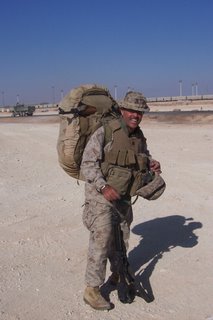
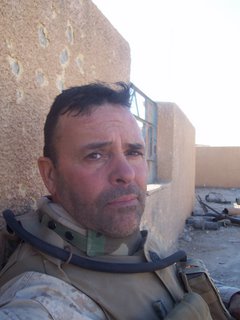
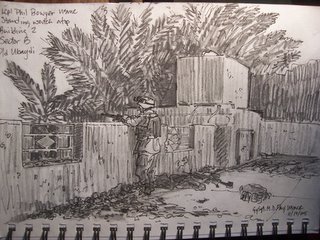
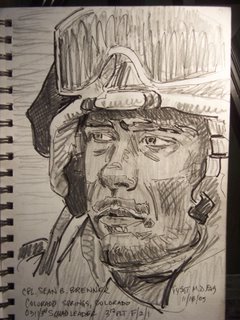

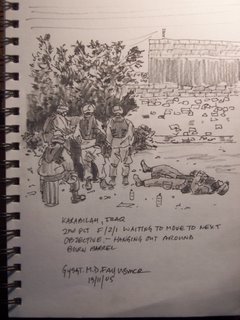
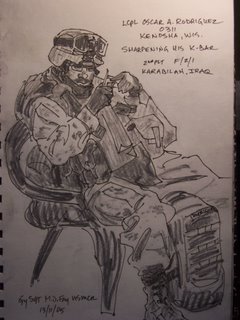


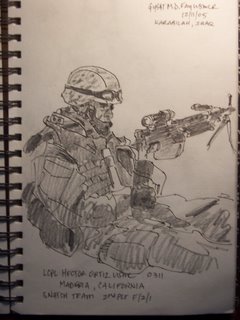

"People sleep peaceably in their beds at night only because rough men stand ready to do violence on their behalf." George Orwell
Combat is a paradoxical dish whose recipe asks for generous dollops of the murderous garnished with a few dashes of the mundane. I was with Fox Company, 2nd Battalion of the 1st Marine Regiment from November 8th through the 19th for Operation Steel Curtain. These were 12 uninterrupted days and nights of combat against a devious and determined foe well apprised of our intention to do them harm. The local population was informed in no uncertain terms 24 hours ahead of time that the Marines would be attacking the following morning. There was no element of surprise. Civilians had to be taken into consideration and given the opportunity to exit from neighborhoods generously salted with foreign fighters; neighborhoods that would shortly boil over into lethal killing zones. Yet, even in the midst of the carnage Marines sandwiched everyday activities into the chaotic mix. Activities such as shaving, burning trash, sharpening knives, joking with buddies, reading paperbacks, playing chess with Iraqi soldiers, and writing letters served as simple punctuation marks between greater paragraphs of violence. These Marines even made time to celebrate the birthday of the Marine Corps, November 10th, with near-beer, steak and a slice of cake. Many greeted each other with a cheery "happy birthday Marine". An Associated Press writer, Jacob Silberberg, remarked to me that these young Marines,in the world of e-mail, must be the last people writing, reading, and longing for letters, and the only ones of their generation reading books for just for the sake of reading.
Today is Thanksgiving Day. I am thankful to be alive. I am thankful for my beautiful daughter, Ainsley, and a loving and supportive family headed by my gorgeous Mom. I am grateful to be a part of this noble cause, and to be surrounded by the finest young men and women I shall ever know......rough men all. Include them in your prayers and thanksgiving.
Saturday, November 19, 2005
In From the Cold
I've just arrived back at Al Qa'im after 11 days in the field with Fox Company, 2nd Battalion of the 1st Marine Regiment (F/2/1). The operation I covered with them was called "Steel Curtain". This operation was aimed at eliminating insurgents and their infrastructures in several key towns, starting at the Syrian border and moving west along the Euphrates River Valley. The fighting was intense and bloody. I'm beat. Tomorrow is Sunday and it will definitely be a day of rest for me. As soon as I can recharge myself, my digital camera and get back to my studio at Camp Fallujah I will post imagery, both photos and art. By that time hopefully I'll have processed the experience enough to give you a cogent account of what occured.
Tuesday, November 08, 2005
Back Out West
Yesterday I spent 6 hours in a CH-53E (Super Stallion) helicopter making my way to Al Qaim, on the Syrian border. Today I'll be heading out into the field. It may be a little while before I get to post anything. I want to thank all you folks for checking out my site. I've been up for about 48 hours so I'm going to sign off and get a little shut-eye. Oh yes, experiencing a new sensation.....it's getting ccccold here.
Thursday, November 03, 2005
The Far Keening of the Pipes
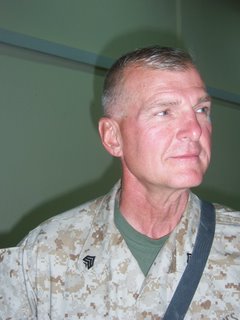
Sergeant Jim Roper USMCR

Lieutenant Colonel Patrick Carroll USMC
In a previous post I used the word consanguinity. Its origin comes from the Latin word for blood and can be used to mean "in the blood", or "of the same blood". It comes to mind how the word blood is used in a variety of passionate phrases; getting your blood up, swearing a bloody oath, he saw blood, or to one's marrow (the source of blood). One thing that will definitely get my blood fired up is the sound of bagpipes. The drone of pipes will drag me out of the house and down the street in search of its source. Here at Camp Fallujah there is a piper named Lieutenant Colonel Patrick Carroll. I first heard him night before last practicing outside in the dark. Many pipers practice late at night out-of-doors. LtCol Carroll echoes what many pipers believe, practicing indoors will either make you deaf, or drive you mad.
Another interesting and inspirational Marine I've met is Sergeant Jim Roper. Sgt. Roper is a Marine Reservist hailing from Oklahoma City, Oklahoma. In his civilian life he's a Major in the Oklahoma State Highway Patrol. Over here he's with civil affairs, working to restore Iraq's economy and legal system. What's so special about Sgt. Roper? Sgt. Roper was originally in the Marines as a MP from 1972 to 1976. At the age of 53, almost 30 years after he hung up his dress blues to become a highway patrolman, he re-enlisted into the Reserves! 9/11 got his blood up. He heard the far keening of the pipes, left the plow in mid-furrow, kissed Mama goodbye, shouldered his rifle and returned to serve in the War on Terrorism. This gentleman is neither summer soldier nor sunshine patriot. When you turn on the news tonight and watch the faces of politicians and celebrities remember that men like Sgt. Jim Roper are the stuff that America was and continues to be forged out of, and those parading across your TV screen could use a marrow transplant from a guy like this. Semper Fi!
Wednesday, November 02, 2005
In the Shades



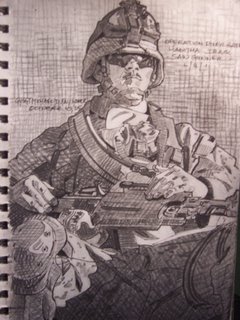

One of the first things I noticed about the look of Marines this trip is the prevalence of sunglasses. Not that GIs haven't worn shades in the past, but during this phase of Operation Iraqi Freedom ballistic sunglasses are mandatory. The threat of explosions from any number of sources necessitates them. There are several challenges to rendering Marines when they're all suited up. The new digital cammies have a subtle pattern meant to confuse the eye. The Kevlar helmet is a complicated shape, and when paired with a camouflage covering looks different from every angle. And finally, the high-tech sunglasses have a distinctive shape all their own, yet give a certain anonymous look to each individual when they're worn. On top of all this each Marine has his or her own idiosyncratic way of wearing their "782 gear" (782 gear is Marinespeak for combat regalia). Being a dyed-in-the-wool realist, I'm not satisfied until each of these surfaces and shapes are captured with a graphic honesty.
Another visual aspect of Marines out in the field is the condition of their uniforms. These guys go for weeks working, sweating and sleeping in the same set of clothes. The result? Impregnated with dirt, and the salt residue from dried sweat, they take on a texture somewhere between sackcloth and cardboard, something analogous to grade school paper mache. My challenge? To try and capture the stiffness (and also suggest the discomfort) of a uniform that is meant to soften the outlines of the Marine wearing it.
Here's a series of drawings with these elements in mind. I've also included a drawing of an Iraqi interpreter, aka "terp". All these terps have a price on their head. They bravely work and share hardship with the Marines, and are allowed to wear our distinctive cammies. This sketch shows a terp with Lima Company 3rd Battalion 1st Marine Regiment in the casual act of rolling up his sleeves. He's a big guy, and like most Iraqi males sports a couple days of beard growth.
The weather here this past week is markedly cooler. Clouds have appeared with the occassional rain shower where weeks ago there was a rubber stamp forecast of blue skies and high temps with an intermittent light dusty wind. The one thing that I REALLY miss this time of year is the changing leaves.
Subscribe to:
Posts (Atom)